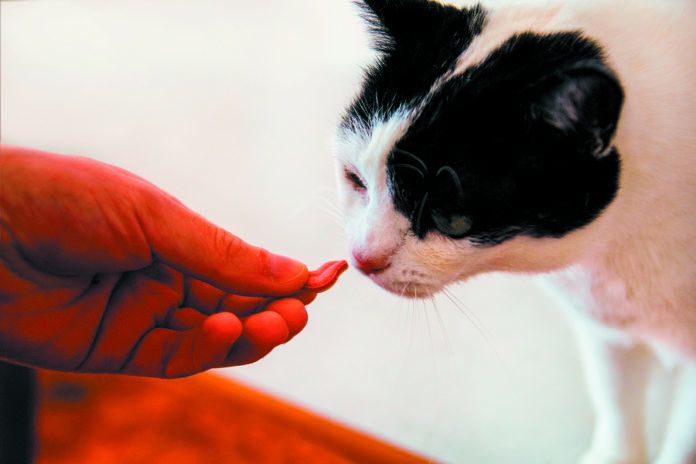While cat owners know their pets are bonded to them, felines are often thought of as uninterested in collaborating with people. It’s believed all communication has to be entirely on their terms, without any give and take. But that’s not true.
Cats can and do learn various behaviors through training. People teach their feline pets to sit, to stop meowing if they want to be fed, to scratch on a scratching post rather than the furniture, and other “tricks.” How?
Through positive reinforcement. That’s how cats learn best, says the American Association of Feline Practitioners. Positive reinforcement means you reward a cat for behavior you desire.
When to reward
The reward has to come immediately for the cat to understand that it’s about the behavior you want to reinforce. If you wait more than 2 or 3 seconds, he will not get the sequence and think you’re rewarding him “just because” or for some behavior that came after the behavior you were interested in getting him to engage in.
For instance, if you want your cat to use the scratching post, entice him to do so and then, immediately after he does, dispense the prize.
What to reward
The reward will differ depending on what your cat prefers. It has to be something very desirable to the cat, or he will not be interested in working with you. For some cats it’s an especially delicious treat. For others, it’s catnip, interactive play, stroking, or grooming. You know your cat and what he thinks of as having high value.
The power of ignoring undesirable behavior
The other component of positive reinforcement, along with providing rewards, is ignoring behavior that you consider undesirable. It can be extremely effective. For instance, let’s say you don’t like it when your cat keeps meowing to be fed. Then do not feed him when he is meowing. That only serves to give him the clearest message that his vocal demands work. Instead, ignore his vocal pleas. When he finally stops meowing, put his food down in the bowl, perhaps with a special treat given by hand as an appetizer. That will help him learn that not meowing is what does the trick.
The role of punishment
While ignoring undesired behavior and rewarding sought-after behavior can work wonders, what doesn’t work is active punishment. You should never punish a cat for not complying with your cue to engage in a particular behavior. The American Association of Feline Practitioners rightly points out that such punishment can lead to a cascade of negative effects.
The results of punishing a cat
- fear and possible aggression because of the fear.
- stress and a decline in health because of the stress (feline physical health is very related to feline emotional health).
- A breakdown in your bond with your pet.
Punishment is not only physical in nature. Verbal punishment — a harsh tone — can also result in increased fear and other deleterious effects as well as inadvertently put extra attention on the undesired behavior. Trust your instinct to always treat your cat with respect.




